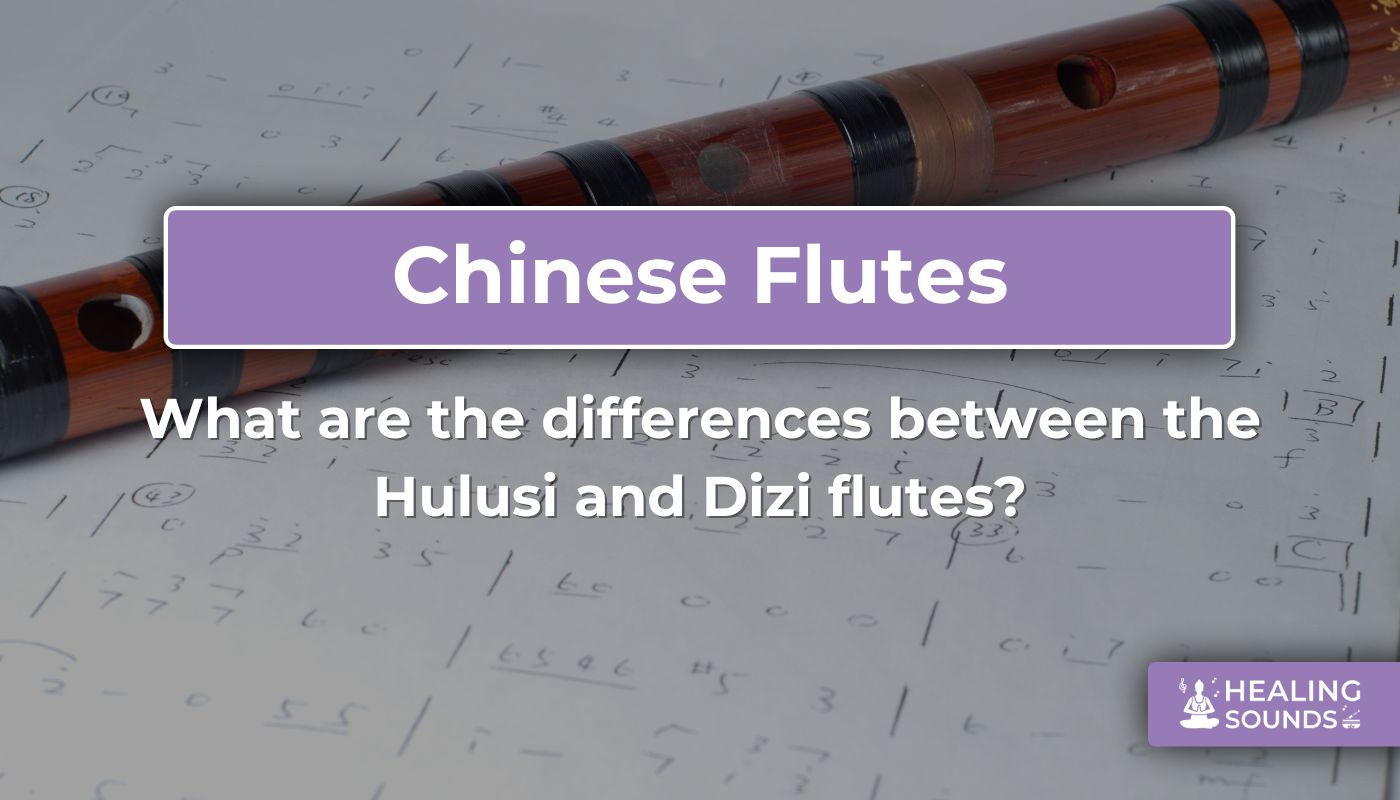Die Entdeckungsreise traditioneller chinesischer Flöten eröffnet eine Welt voller Geschichte und fesselnder Klänge. Zu den beliebtesten Instrumenten zählen die Hulusi und die Dizi . Obwohl beides chinesische Flöten sind, bieten sie deutlich unterschiedliche musikalische Erlebnisse. Dieser Leitfaden untersucht den Vergleich zwischen Hulusi und Dizi und beleuchtet ihre einzigartigen Eigenschaften, Klänge und idealen Einsatzmöglichkeiten. Ob Sie Musiker auf der Suche nach einer neuen Stimme sind, sich zu meditativen Klängen hingezogen fühlen oder einfach neugierig auf Weltmusik sind – das Verständnis dieser Unterschiede wird Ihnen helfen, die einzigartige Schönheit jeder Flöte zu schätzen.
Was ist eine Hulusi-Flöte?
Die Hulusi-Flöte (葫芦丝) ist ein Blasinstrument mit freiem Rohrblatt, das von den ethnischen Minderheiten der chinesischen Provinz Yunnan stammt. Ihr Name bedeutet „Kürbisseide“ und bezieht sich auf ihre Konstruktion aus einem Flaschenkürbis und Bambusrohren sowie ihren weichen, fließenden Klang.
Charakteristisch für die Hulusi sind ihre eindringlich schönen und ruhigen Melodien. Sie besteht typischerweise aus einer Hauptpfeife mit Grifflöchern und ein oder zwei Bordunpfeifen, die eine konstante Harmonie erzeugen. Diese Kombination erzeugt einen reichen, weichen und leicht pfeifenden Ton, der oft als beruhigend und melancholisch beschrieben wird und sich daher hervorragend für Entspannungs- und Meditationsübungen eignet.
Was ist eine Dizi-Flöte?
Die Dizi-Flöte (笛子) ist eine quer geblasene Bambusflöte , die in verschiedenen Genres der chinesischen Musik eine herausragende Rolle spielt, von Volksliedern über moderne Kompositionen bis hin zur traditionellen Oper. Sie ist eines der ältesten und am weitesten verbreiteten chinesischen Blasinstrumente.
Ein wesentliches Merkmal der Dizi ist der „Mokong“ (膜孔), ein zusätzliches Loch, das von einer dünnen Membran, dem „Dimo“ (笛膜), bedeckt ist, die meist aus Schilf oder Bambushaut besteht. Beim Spielen vibriert diese Membran und verleiht dem hellen und lebendigen Klang der Dizi ein charakteristisches, summendes, resonantes Timbre. Dizi-Flöten sind für ihren ausdrucksstarken Tonumfang und ihre Beweglichkeit bekannt und können sowohl energetische, durchdringende Töne als auch sanftere, lyrische Melodien erzeugen.
Hulusi vs. Dizi: Wichtige Unterschiede auf einen Blick
Das Verständnis der wesentlichen Unterschiede kann Ihnen bei der Auswahl helfen. Hier ein kurzer Vergleich:
| Besonderheit | Hulusi-Flöte | Dizi-Flöte |
|---|---|---|
| Konstruktion | Kürbiskörper mit Bambusrohren (Haupt- + Bordunrohr) | Einzelnes Bambusrohr, quer (seitlich geblasen) |
| Hauptmerkmal | Bordunpfeifen sorgen für Harmonie | Dimo-Membran erzeugt summendes Timbre |
| Klangprofil | Heiter, sanft, schrill, eindringlich, meditativ | Hell, resonant, lebendig, durchdringend, summend |
| Spieltechnik | Gleichmäßiger Atem, einfachere Fingertechnik (zunächst) | Erfordert Ansatzkontrolle, Fingerbeweglichkeit und Dimo-Anpassung |
| Häufige Verwendungen | Meditation, Entspannung, Soloauftritt, Volksmusik (Südwestchina) | Orchester, Folkloreensembles, Oper, Soloauftritte, Feste |
| Wahrgenommene Schwierigkeit | Wird oft als einfacher für Anfänger angesehen | Kann aufgrund von Ansatz und Dimo anfangs schwieriger sein |
Konstruktion und Materialien: Ein genauerer Blick
Die physische Form und die Materialien beeinflussen den Klang und das Spielerlebnis jeder Flöte stark.
Der Hulusi: Kürbis- und Bambuspfeifen
Die einzigartige Form der Hulusi verdankt sie ihrem Hauptbestandteil: einem natürlichen Flaschenkürbis. Dieser dient als Windkammer. Daran sind typischerweise drei Bambusrohre befestigt. Das längste, mittlere Rohr hat Grifflöcher zum Spielen von Melodien, während die kürzeren äußeren Rohre oft als Borduntöne fungieren und einen festen Oberton spielen. Bei einigen modernen Hulusi lassen sich die Borduntöne ein- und ausschalten. Die Kombination aus Flaschenkürbis und Bambus verleiht der Hulusi ihren charakteristischen warmen, resonanten Klang.
Das Dizi: Bambus und die Dimo-Membran
Die Dizi wird typischerweise aus einem einzigen Stück Bambus gefertigt, das sorgfältig nach Qualität und Resonanz ausgewählt wird. Gängige Arten sind Purpurbambus (紫竹) und Weißbambus (白竹). Das entscheidende Element ist die Dimo-Membran, die über das Mokong-Loch zwischen Mundstück und Grifflöchern gespannt ist. Diese vibrierende Membran ist entscheidend für den hellen, summenden Ton der Dizi. Das Anlegen und Einstellen der Dimo ist eine Kunst für sich und beeinflusst die Reaktionsfähigkeit und Klangfarbe des Instruments.

Hulusi-Flöte aus Ebenholz/Palisander – 3 Töne, C/Bb-Tonart
$89.99 $129.99
Erleben Sie den meditativen Klang der Hulusi mit dieser hochwertigen Flöte aus Ebenholz und Palisander, die satte, vielseitige Töne in C- oder B-Tonart bietet.
Entdecken Sie Ebony HulusiSoundprofil-Showdown: Hulusi vs. Dizi Sound
Der größte Unterschied liegt in ihren unterschiedlichen Klangqualitäten, die unterschiedlichen musikalischen Stimmungen und Vorlieben gerecht werden.
Die eindringlichen Melodien der Hulusi
Der Klang der Hulusi wird oft als weich, sanft und tief berührend beschrieben. Die Bordunpfeifen sorgen für eine konstante Harmonie und erzeugen eine volle, leicht pfeifende Textur. Ihre sanfte Lautstärke und ihr beruhigendes Timbre machen sie ideal für intime Momente, persönliche Besinnung und die Schaffung einer Atmosphäre der Ruhe und Entspannung. Stellen Sie sich ruhige Landschaften und stille Kontemplation vor.
Die lebendigen Töne der Dizi
Im Gegensatz dazu liefert die Dizi einen hellen, klaren und durchdringenden Klang . Die vibrierende Dimo-Membran verleiht ihr eine einzigartige Resonanz und ein charakteristisches Summen, wodurch sie sich in Ensembles durchsetzen kann. Die Dizi ist unglaublich ausdrucksstark und ermöglicht schnelle Passagen, Triller und dramatische Dynamikwechsel. Ihre Energie macht sie perfekt für lebendige Volksmusik, Orchesterstücke und feierliche Anlässe.
Spieltechniken und Schwierigkeit
Obwohl beides Übung erfordert, unterscheiden sich die anfängliche Lernkurve und die Techniken.
Ist Hulusi leichter zu lernen?
Viele Anfänger finden die Hulusi anfangs etwas leichter. Sie benötigt typischerweise weniger Luftdruck als die Dizi, und die Ansatztechnik (Mundhaltung) ist im Allgemeinen unkompliziert – man bläst einfach in das Mundstück. Die Grifftechnik ist relativ direkt. Dennoch erfordert es Hingabe, einen nuancierten Ausdruck zu erreichen und die Atemkontrolle für einen gleichmäßigen, gleichmäßigen Klang zu beherrschen.
Die Dizi meistern
Die Dizi stellt besondere Herausforderungen dar. Um einen klaren, stabilen Ton zu erzielen, ist die richtige Ansatzkontrolle für die Querblastechnik erforderlich. Fingerfertigkeit ist entscheidend für die schnellen Melodien, die oft auf der Dizi gespielt werden. Darüber hinaus ist das Erlernen des richtigen Anlegens und Spannens des Dimo für seinen charakteristischen Klang unerlässlich. Zur häufig gestellten Frage: „Ist die Dizi schwieriger als die Flöte?“: Im Vergleich zur Hulusi erfordert die Dizi oft mehr technisches Grundwissen, insbesondere in Bezug auf Ansatz und Dimo-Kontrolle.
- Hulusi: Konzentrieren Sie sich auf eine gleichmäßige Atmung, um den Dröhnklang und die Melodie beizubehalten. Experimentieren Sie mit leichtem Pitch Bending für mehr Ausdruck.
- Dizi: Üben Sie lange Töne, um die Stabilität des Ansatzes zu entwickeln. Lernen Sie frühzeitig die Grundlagen der Dimo-Anwendung. Arbeiten Sie an sauberen Fingerübergängen.
Entdecken Sie unsere Dizi- und Hulusi-Flöten

23,90 €
28,00 €
Beginnen Sie Ihre Dizi-Reise mit dieser erschwinglichen Flöte, die sich perfekt zum Erlernen der Grundlagen dieser lebendigen chinesischen Flöte eignet. Mehr erfahren ➔

44,90 €
52,00 €
Erleben Sie überragende Klangqualität mit dieser handgefertigten Dizi aus gealtertem Bambus, ideal für fortgeschrittene Spieler, die Hulusi- und Dizi -Klänge ausprobieren möchten. Mehr erfahren ➔

89,99 €
129,99 €
Entdecken Sie den vollen, resonanten Klang der Hulusi mit diesem wunderschönen Modell aus schwarzem Bambus, das Ästhetik und traditionelle Töne vereint. Mehr erfahren ➔
Ideale Einsatzmöglichkeiten: Wann Sie welche Flöte wählen sollten
Ihr beabsichtigter Anwendungsfall ist ein wichtiger Faktor bei der Entscheidung zwischen Hulusi und Dizi .
Hulusi für Meditation und Entspannung
Mit seinem beruhigenden und sanften Klang eignet sich das Hulusi hervorragend für Meditation, Achtsamkeitsübungen, Klangheilungssitzungen und ruhiges Solospiel. Seine wohltuenden Töne schaffen eine friedliche Atmosphäre, die zur Entspannung und Selbstreflexion einlädt.
Dizi für Aufführungen und Volksmusik
Der helle, kraftvolle Klang der Dizi macht sie ideal für Auftritte, ob solo, in kleinen Ensembles oder großen Orchestern. Sie ist ein fester Bestandteil der chinesischen Volksmusik, der Opernbegleitung und bei feierlichen Anlässen, bei denen ihr energetischer Klang wirklich zur Geltung kommt.
Kulturelle Bedeutung und Geschichte
Beide Flöten haben tiefe kulturelle Wurzeln in der chinesischen Musiktradition.
Der Hulusi ist eng mit den ethnischen Minderheiten der Dai, Yi und Achang im Südwesten Chinas verbunden. Er spielt eine wichtige Rolle in deren Volksmusik, Festen und Balzritualen und symbolisiert ihre kulturelle Identität und Verbundenheit zur Natur. Seine Musik erinnert oft an die landschaftliche Schönheit der Region Yunnan.
Die Dizi blickt auf eine jahrtausendealte Geschichte zurück, die in alten Texten dokumentiert und in historischen Kunstwerken dargestellt ist. Sie hat sich über Jahrhunderte weiterentwickelt und ist fester Bestandteil verschiedener Formen chinesischer Musik in unterschiedlichen Regionen und Gesellschaftsschichten geworden. Ihre Vielseitigkeit hat sie zu einem der beliebtesten traditionellen Instrumente Chinas gemacht. Mehr über die Vielfalt chinesischer Musikinstrumente erfahren Sie beispielsweise in der Heilbrunn Timeline of Art des Metropolitan Museum of Art .
Die Wahl Ihrer Flöte: Kosten- und Qualitätsaspekte
Sowohl Hulusi- als auch Dizi-Flöten sind in verschiedenen Preisklassen erhältlich. Im Allgemeinen können Anfängermodelle für beide Typen recht erschwinglich sein.
Zu den kostenbeeinflussenden Faktoren zählen die Qualität der Materialien (z. B. Art und Alter des Bambus, Kürbisqualität bei Hulusi, spezielles Holz bei Premiummodellen), die Handwerkskunst, die Verzierungen und der Ruf des Herstellers. Einfache Dizi-Flöten für Schüler sind möglicherweise etwas günstiger als einfache Hulusi-Flöten, aber hochwertige, professionelle Instrumente beider Typen stellen eine größere Investition dar.
Berücksichtigen Sie bei der Auswahl Ihr Budget, legen Sie aber auch Wert auf eine Ihrem Niveau und Ihren Zielen entsprechende Klangqualität und Spielbarkeit.
Hulusi vs. Dizi vs. Xiao: Eine kurze Anmerkung
Manchmal wird auch nach der Xiao (箫) gefragt, einer anderen traditionellen chinesischen Bambusflöte. Im Gegensatz zur querliegenden Dizi ist die Xiao eine Längsflöte, die wie eine Blockflöte vertikal gehalten wird. Im Vergleich zur Dizi erzeugt sie einen sanfteren, weicheren und hauchigeren Klang und wird oft für kontemplative Musik verwendet. Während die Dizi hell und surrend klingt und die Hulusi pfeifend und weich mit Borduntönen, bietet die Xiao einen reinen, heiteren und wehmütigen Ton. Dieser Artikel konzentriert sich auf den Vergleich zwischen Hulusi und Dizi , doch das Verständnis der Xiao erweitert den Kontext der reichen Familie chinesischer Flöten.
Fazit: Finden Sie Ihren Sound
Die Wahl zwischen Hulusi und Dizi hängt maßgeblich von Ihrem bevorzugten Klang und Ihrem Einsatzzweck ab. Die Hulusi-Flöte ermöglicht mit ihrer einzigartigen Kürbis- und Bordun-Konstruktion ruhige, meditative Melodien. Die Dizi-Flöte bietet einen lebendigen, ausdrucksstarken Klang, der sich für lebhafte Darbietungen und Ensemblespiel eignet und sich durch ihr helles, surrendes Timbre auszeichnet.
Beide Instrumente bieten eine lohnende Reise in die Welt der chinesischen Musik und Kultur. Entdecken Sie die Klänge, denken Sie über Ihre musikalischen Ambitionen nach und lassen Sie sich von Ihrer Intuition leiten. Bei Healing Sounds bieten wir eine kuratierte Auswahl hochwertiger Hulusi- und Dizi-Flöten, die Sie bei Ihren musikalischen Entdeckungsreisen und Wellness-Praktiken unterstützen.
Häufig gestellte Fragen zu Hulusi- und Dizi-Flöten
Vergleicht man die Dizi speziell mit der Hulusi, wird die Dizi für Anfänger oft als anspruchsvoller angesehen. Dies liegt vor allem daran, dass man ein korrektes seitliches Mundstück entwickeln und die „Dimo“-Membran für ihren charakteristischen Klang beherrschen muss. Die Längsblastechnik der Hulusi und der gleichmäßigere Luftbedarf können sich anfangs intuitiver anfühlen.
Die Hulusi besteht traditionell aus einem natürlichen Flaschenkürbis, der als Windkammer dient, und mehreren daran befestigten Bambuspfeifen. Typischerweise gibt es eine Hauptmelodiepfeife mit Grifflöchern und ein oder zwei kürzere Bordunpfeifen.
Hulusi ist die Pinyin-Transliteration des chinesischen Namens des Instruments, der als 葫芦丝 geschrieben wird. „Hulu“ (葫芦) bedeutet Kürbis und „si“ (丝) bedeutet Seide, was sich metaphorisch auf den sanften Klang bezieht oder manchmal als Hinweis auf das Rohrblatt interpretiert wird.
Die Hauptunterschiede liegen in der Spielrichtung und im Klang. Die Dizi ist eine Querflöte (seitlich geblasen) mit einer Membran („Dimo“), die einen hellen, summenden Klang erzeugt. Die Xiao ist eine Längsflöte (vertikal geblasen) ohne Membran, die einen weicheren, sanfteren und hauchigeren Ton erzeugt und häufig für introspektive Musik verwendet wird.
Die Dizi hat aufgrund ihrer „Dimo“-Membran einen hellen, klaren, resonanten und etwas summenden Klang und wird oft für lebhafte und kraftvolle Musik verwendet. Die Hulusi hat einen viel weicheren, sanfteren, röhrenden und manchmal eindringlichen Klang, der oft harmonische Borduntöne aufweist und sich daher für ruhige und meditative Stücke eignet.

